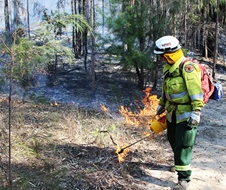The NSW National Parks and Wildlife Service (NPWS) will be conducting 2 hazard reduction burns in Blue Mountains National Park, Wednesday 11 September, weather permitting.

A 362 ha burn will take place between Medlow Bath and Blackheath to the east of the Great Western Highway.
The burn will begin in the morning with crews continuing into the evening. Crews will be present for a number of days after the burn.
The low intensity burn is being undertaken over 2 days to reduce fuel loads in the area and help maintain water quality.
A second hazard reduction burn will go ahead at Glenbrook. The 23 ha burn, close to the Glenbrook Train Station, is a low intensity hazard reduction burn that will reduce the potential impact of wildfires to residential properties along Bruce Road and Wright Street.
Smoke from the Upper Mountains burn may impact on the area around Medlow Bath and Blackheath, especially along Rutland Road and Grand Canyon Road, and drivers along the Great Western Highway are warned to take care.
Minimal smoke impact from the Glenbrook burn is expected in local streets and at the Glenbrook Train Station.
People with asthma or who are susceptible to respiratory problems are advised to stay indoors, close windows and doors, and follow their health plan.
NPWS will be assisted by Rural Fire Service, Fire and Rescue NSW, and WaterNSW.
This burn is one of many hazard reduction operations undertaken by NPWS each year, many with assistance from the Rural Fire Service and Fire and Rescue NSW.
All burns around the state are coordinated with the NSW Rural Fire Service to ensure the impact on the community is assessed at a regional level.






